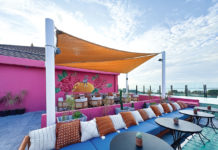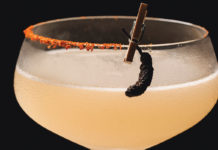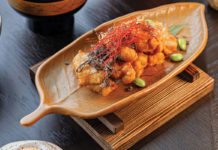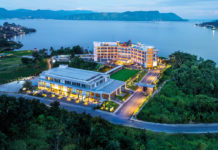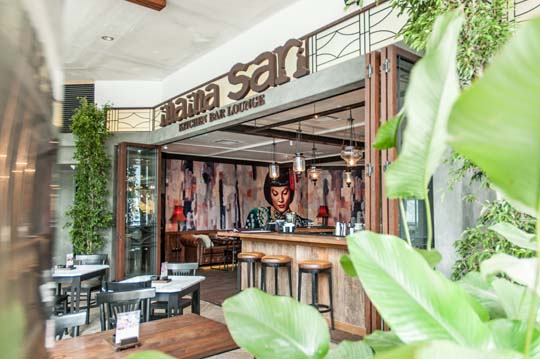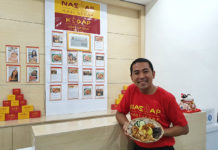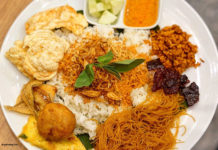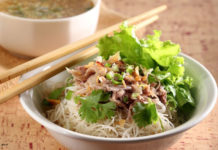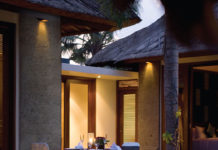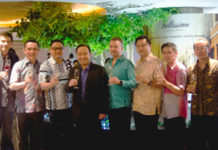Will Meyrick – the highly regarded Asian Street Food Chef – seems well on course to becoming one of Asia’s most influential restaurateurs. In Bali, Jakarta, Hong Kong and now Kuala Lumpur, he is spreading his passion for exquisitely presented authentic plates through his growing number of highly successful and acclaimed Asian restaurants.
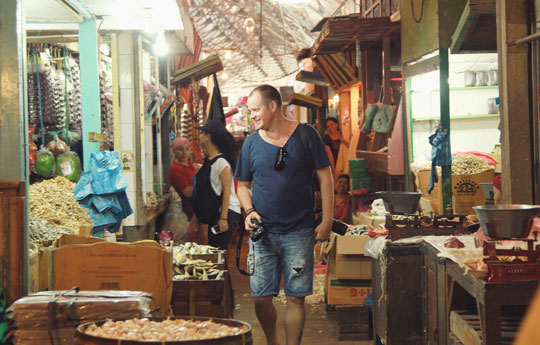
Will’s quite extraordinary culinary journey began in London, before he moved to Sydney where he honed his skills at Longrain and Jimmy Liks. After extensive travels through the South East Asian gastronomic hotspots, he found his way to the paradise island of Bali, where he opened the Sarong Fine Dining restaurant.
His well-documented travels throughout the region in search of original recipes have become almost folklore, but whether in Bangkok or Burma you won’t find Will seeking excellence in the designer kitchens. Instead, he will be found in the very heart of Asian cuisine, with street vendors, at the local market or embedded in family kitchens.
His latest opening was Mama San, Kuala Lumpur and coming soon, in early November, is the exciting Tiger Palm in Seminyak, Bali. His fourth restaurant on the island, Tiger Palm can be found in The Village, Seminyak’s stylish new shopping and dining experience on Jalan Kayu Cendana in Seminyak.
With seating for 110, Tiger Palm keeps faith with the Sarong Group’s approach to classic interior designs with its tropical mid-century modernism. Add just a soupçon of vintage Malay and Tiki pop style and Tiger Palm evokes a timeless energy and appears just as perfect for a relaxed lunch or dinner as it is for a quick pitstop between shops.
It’s an extremely busy time for the Sarong Group, but Will took time out of his hectic schedule to chat with Asia Dreams about Tiger Palm, its concept and menu.
Q: Tiger Palm is your fourth restaurant in Bali. How will it be different from the others?
A: Each of our restaurants is unique, each decidedly different from the others. Tiger Palm has a character that, just like Sarong, Mama San, E&O and Hujan, is particular to its name. The ambiance is elegant, yet casual, and for the first time we are going to have a restaurant that opens all day long, serving breakfast in the morning, followed by all-day dining and then dinner, continuing into the night with after-dinner drinks.
Q: Is there a story behind the name?
A: The tiger is very close to the heart of Chinese people. It’s a symbol of power and harmony and the five claws of the tiger symbolise the five values of life we have adopted from Peranakan culture, which cover the power of team and the harmony in diversity. Malaysian culture has developed from a few different cultures and Chinese is one of the strongest influences. Meanwhile, the palm reminds us of island life as can be found in Bali and Penang Island in Malaysia, where most of our dishes come from.
Q: What’s the concept, the goals, of Tiger Palm?
A: To offer something refreshing and new, something that brings the richness of Malaysian cuisine history into the modern day. The menu offers the cuisine culture of Malaysia, presents the historic influences of Nyonya, Thai and Peranakan Jawi cuisines, of the Chinese traders and self-starting businessmen from Southern India. You can see that in the richness of the cultures from the dishes, such as the famous Nasi Kandar.
Q: So what new dishes can diners expect?
A: Plenty! Kopitiam-style breakfast with dim sum, such as Chee Cheong Fun, Chicken Balls Rice, Coddled Eggs, Nasi Lemak, Apam with Fish Curry, Char Kuay Teow, Nyonya Laksa, Wan Tan Mee and Penang Hokien Mee.
The lunch and dinner menus include fresh Malaysian kerabu salads, Five-Spice Lobak, Mee Goreng Mamak, Southern Indian dishes served on banana leaf, Duck Korma, Asam Pedas Malaysian Fish Curry, Devil’s Curry of Roasted Pork, Stir Fry Sambal Tumis Sotong, Crispy Whole Fish with Ginger Flower and Tandoori. And for late night nibbles, Tiger Palm presents Tandoori wraps throughout the night.
Q: With restaurants all across the region, in Bali, Jakarta, Hong Kong and Kuala Lumpur, what are your biggest practical challenges and how do you deal with them?
A: Keeping the consistency of all the restaurants with different concepts is not an easy job and meeting the expectations from different consumer markets can be very tricky. How to deal with it? We customise menus, tweak them here and there, to meet each market’s expectation. Me and Palm – my “chef in crime” – also spend time in each restaurant regularly to keep the consistency.
Q: I notice a number of your restaurants, like the new Tiger Palm in Seminyak, are located in shopping malls. Is this something that has been intentionally developed and if so, why?
A: It’s a practical approach. In Bali, as land has become more expensive, it makes sense to look at other concepts for dining locations.
Q: I know you take a lot of time understanding the local heritage that underpins the styles and even dishes you create. Why do you think that is important?
A: It is very hard to cook other region’s dishes if you don’t understand the culture and the people. For me it’s like being an actor, like Robert De Niro in Raging Bull. It’s pretty much like how I take on my research. I travel, I meet the people, talk and learn from them – so I can be more like an Asian that has been doing this for a long time to keep the authenticity, but also add a modern twist to take the dishes to the next level.
Q: From your culinary travels, what is the success rate? How many recipes, say out of 10, will make it to the table?
A: I don’t calculate the success rate that way, really. I am happy when I can learn a lot from the women I meet in the villages. I can spend some time with them and they can accept me almost like a family member. But talking about technical challenges, most of the time it is more about what dishes come to which restaurant.
Q: The last few years have seen you open restaurants, travel the region and develop some superb dining experiences. What’s next?
A: To sustain all the restaurants and allow the restaurants to be learning centres for my Indonesian staff to gain more knowledge and understanding about their cuisine culture, as well as those of other regions. I would love to see them grow internationally.
Q: It’s often referred to as Asian street food, but how would you actually describe what you do?
A: People regard my food as fusion or modern Asian, but I like to see it as regional authentic food cooked with Western hands. As a lady in Padang told me, I cannot copy her dishes because every hand cooks differently.
There’s a misconception that when people eat so-called street food in high-end restaurants, then ultimately it’s not an authentic experience. But if we serve the dishes as they are served on the street then people will just go down to the vendor and get it there, for half of the price.
The people who have travelled to regional parts of Asia will understand and will recognise where my ideas come from and respect the time I take to learn what I have learned.
Mama San Kuala Lumpur, by Chef Will Meyric
For the discerning diners of Kuala Lumpur, the city dining scene has just become a lot more interesting with the opening of Mama San Kuala Lumpur – celebrated Chef Will Meyrick’s first eatery in Malaysia.
For those who have dined at Hujan Locale, Sarong or Mama San in Bali, Mama San Hong Hong or E&O in Jakarta, the charming Scot, his concepts and culinary excellence will need no introduction. But for those yet to have had that privilege, well, suffice it to say his reputation for extraordinary Asian dining, built on the back of his legendry forays throughout Asia, is fully deserved.
Will is a highly respected and experienced chef and restaurateur, but what makes him stand out most, and definitely what helps give his food the WOW factor, is the passion and effort he puts into finding the traditional street recipes and flavours that will shine in his restaurants.
He is a tireless culinary traveller with a near obsession for Asian street food and culture, from which he takes the inspiration to marry traditional ingredients with contemporary presentation and techniques resulting in the Asian favourites he presents across his epicurean empire.
The à la carte menu at Mama San, Kuala Lumpur is a treasure trove of quality Asian street food adapted to meet the demands of the contemporary diner. Using only the best ingredients to achieve authentic tastes, smells and textures, Chef Will Meyrick serves up starters and salads such as lamb martabak with curry powder, egg and leek served with pickled cucumber relish and tamarind dressing; ginger and shallot sashimi with snapper salmon; crispy sotong with chilli jam, ginger flower, lemongrass and honey; and chicken and pomelo salad with lime leaf, white coral mushroom and sesame seeds.
The mains selection is sorted into meats, fish, seafood and poultry. A classic Indonesian meat dish, Meyrick’s dendeng balado – caramelised beef short ribs with kaffir lime – is superb, as is the five-spice chicken lorbak and Thai lamb shoulder curry with pumpkin. From the poultry section, why not try the Acehnese chicken Korma, or the red curry of BBQ duck served with lychee baby corn tomatoes, Thai basil and pea and apple eggplant?
With so many rivers and rich coastlines, it’s no surprise that fish and seafood play a massive part in Asian street food and for Mama San, Meyrick has put together a sumptuous and authentic selection.
Highly recommended comes the Mama San fish curry with okra tomato tamarind and fish curry powder or, for something a bit more exotic, try the Asam rebus of shark, with banana blossom belimbing wuluh, cauliflower ginger flower and Vietnamese mint.
The restaurant offers an extensive range of beverages to compliment the menu from signature cocktails, like the cooling Coconut Passionfruit Pineapple Daiquiri, to the exclusive house-roasted Kintamani coffees, plus teas, soft drinks and beers. For first-timers or old hats alike, dining at Mama San is always simply exquisite.
————————-
Favourite Feature:
Where would any Asian street food restaurant be without its dose of heady desserts? Well, Will knows this only too well and serves up a selection of some the region’s favourite sweet street dishes at Mama San Kuala Lumpur, including: his Indonesian klappa tart, with raisins, young coconut, almonds and dusted with cinnamon and served with coconut ice cream; Ice cendol with palm fruit, coco de nata, pandan noodles, coconut granita and cincau served with palm sugar syrup; and his very own “Kampung snicker” – a peanut butter parfait with butterscotch and chocolate coated peanuts.
————————
Mama San Kuala Lumpur
Lot G 46, Ground Level, Suria KLCC,
Jalan Ampang, Kuala Lumpur, Malaysia
www.mamasankualalumpur.com


